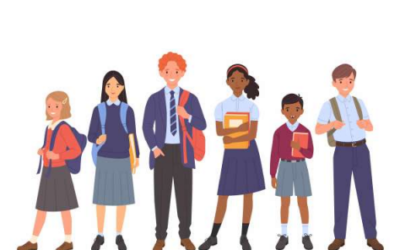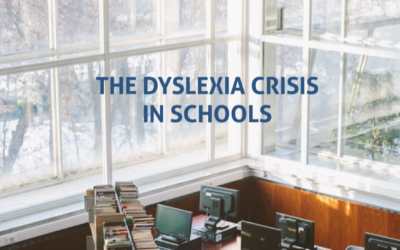If dyslexic students are struggling to decode words, a program of intensive structured literacy will help - but help with phonological awareness may not be sufficient to help them become fluent readers. Why? Because reading fluency, or the ability to read with...
My Pandemic Hack for Classes
Shelley Wear, a long-time volunteer on our Dyslexic Advantage editorial team shared these pandemic hacks for her classroom. Thanks Shelley! "The struggle is real to make sure students understand what you are saying with a mask on. I purchased a personal amplifier...
Dyslexia Advocacy: Say Dyslexia 2.0
From Chalkbeat's story, "NYC plans to screen nearly 200,000 students in the early grades to uncover struggling readers. Then what?" "In a massive bid to gauge reading skills following COVID-related learning disruptions, New York City’s education department is...
Johnpaul Jones: Native American Architect [Premium]
“Where Native people come from, everything’s not in straight lines.” – Johnpaul Jones Johnpaul Jones is one of the world’s leading architectural architects and landscape designers, and he is also dyslexic. He was the lead design consultant for the National Museum of the American Indian, the Bainbridge Island Japanese American Exclusion Memorial, The Southern Ute Cultural Center and Museum, Vancouver Land Bridge, Mountains to Sound Greenway Plan, Oregon Zoo Educational Center, Longhouse Educational and Cultural Center, and Gorilla Conservation Research Center, among many, many others. He has said that his aesthetic was inspired by his Choctaw – Cherokee mother’s four world perspective: natural animal, spiritual, and human. Johnpaul describes his early life as being a “bad boy” and “dyslexic.” He struggled in school, and […]
Understanding Conceptual vs. Procedural Knowledge in Math [Premium]
With math scores lagging tremendously due to pandemic-related school, many of us may suddenly find ourselves responsible for supervising (if not tutoring) math. If that’s the case, it’s important to keep in mind the big picture of math learning. Of course the issue of conceptual and procedural learning apply to all subjects, not just math, but it especially becomes relevant when problem solving can become complex; symbols and abstractions must be used, and multiple steps for problem solving are necessary. There’s an especially nice description of the differences between conceptual and procedural knowledge in math from Ruthie Sloan’s Teach Math Literacy blog. Many of us learned math only through procedural learning. We didn’t learn “why” we did certain steps like “flip upside-down and multiply,” […]
Reading Fluency for College [Premium]
Recently we were contacted by a student who wanted to improve his reading fluency before attending college. He had completed a full course of “Wilson and Orton-Gillingham” yet his reading was still slow and effortful. He asked, “Is there anything I can do to improve my reading to help me be successful in college?” ANSWER: First of all, good for you for looking ahead and preparing yourself for college. It is possible to get through college with slow effortful reading, but probably only if you’re competent with assistive technology and can listen to all of your books instead of reading them traditionally. Although most colleges and universities are required to make “reasonable accommodations,” schools and individual faculty members can vary, and practical issues – […]
Math: Multiple Representations [Premium]
If you have a lot of ground to cover for the coming school year, consider the use of multiple representations to improve the efficiency of learning. First, as a person who is math-challenged herself and was tasked at one time with tutoring one of our kids with similar math difficulties, I am sympathetic to people who are tasked with teaching math. The truth is, I wasn’t good at it myself, so I found myself getting frustrated when my student didn’t understand. I had little flexibility between math representations – and as a result tended to teach math the way I was taught it…rote memory of sequenced steps – which I was to find was the last thing my student should have been trying […]
Dyslexia and Mapping Out the Mind [Premium]
When Dan Pink wrote his book about the world needing more skills of the Conceptual Age, many in the dyslexia community couldn’t help but notice that his list looked a lot like common lists of dyslexic strengths: – Artistry – Inventiveness – Big-picture thinking – Pattern recognition – Empathy The implications for education and careers were straightforward. The goals of education and satisfying work should not be mere mastery of information, but a mastery of concepts that could be used flexibly to solve problems and create things that are new. Pink is not a neuroscientist; he is a popular author and observer of trends. Where are we now in our understanding of “dyslexic thinking”? There are many interesting lines of thought coming together these […]
Dyslexia and Dysgraphia: What Does Writing Look Like? [Premium]
What does the writing look like in students with dyslexia and dysgraphia? IMPAIRED AUTOMATICITY, CAPITAL LETTER INTRUSIONS, and SPELLING ERRORS Students who struggle with handwriting automaticity show irregular shapes and sizes of letters. For example, look at the letter ‘e’ in the spelling test at right. They are very different from one another, showing that the student has not ‘automated’ writing of the letter ‘e’. The more variable the letters are, the more arduous to write anything by hand. Working memory is easily overloaded, and students may be exhausted after writing a few words. The spelling test also shows capital letter intrusions (capital ‘D’), likely to avoid confusing lower case ‘d’ with ‘b’, irregular spacing, and phonological as well as sight word errors. When […]
Foreign Language Learning [Premium]
Q: HOW CAN I IMPROVE MY FLUENCY WITH A SECOND LANGUAGE? Recently, a member of this community asked about how to improve his fluency with a foreign language. He mentioned that he’d been trying to learn for the past 30 years, but only recently started making more progress with the app Yabla because it was visual and didn’t rely on audio alone. Yabla is an interactive video approach to foreign language learning that provides two channels of captions that can be shown or hidden and TV shows, music videos, documentaries, and interviews. A: I can see how Yabla can help with improving speed of listening. The videos provide context and the scenes may make the dialogues more memorable than if they were read […]
The Dyslexia Crisis in Schools
The house is on fire. There is a conflagration of factors coming together that are affecting dyslexic students in public school beyond COVID. COVID certainly has its share of blame and breaking the camel's back when it comes to providing essential services to...
Singer Tony Bennett’s Last Concert
"To me, life is a gift, and it's a blessing to just be alive. And each person should learn what a gift it is to be alive no matter how tough things get." — Tony Bennett Tony Bennett really sounds great at 95 years old. Check out his duets with Lady Gaga below....




![Johnpaul Jones: Native American Architect [Premium]](https://www.dyslexicadvantage.org/wp-content/uploads/2021/10/Johnpaul-Jones-Native-American-Architect-400x250.png)
![Understanding Conceptual vs. Procedural Knowledge in Math [Premium]](https://www.dyslexicadvantage.org/wp-content/uploads/2021/10/conceptual-math-400x250.png)
![Reading Fluency for College [Premium]](https://www.dyslexicadvantage.org/wp-content/uploads/2021/10/Reading-Fluency-2-400x250.jpg)
![Math: Multiple Representations [Premium]](https://www.dyslexicadvantage.org/wp-content/uploads/2021/10/Math-Multiple-Representations-2-400x250.jpg)
![Dyslexia and Mapping Out the Mind [Premium]](https://www.dyslexicadvantage.org/wp-content/uploads/2021/10/Dyslexia-and-Mapping-out-the-Dyslexic-Mind-1-400x250.png)
![Dyslexia and Dysgraphia: What Does Writing Look Like? [Premium]](https://www.dyslexicadvantage.org/wp-content/uploads/2021/10/Dyslexia-and-Dysgraphia-4-400x250.png)
![Foreign Language Learning [Premium]](https://www.dyslexicadvantage.org/wp-content/uploads/2021/10/Foreign-Languages-400x250.png)















